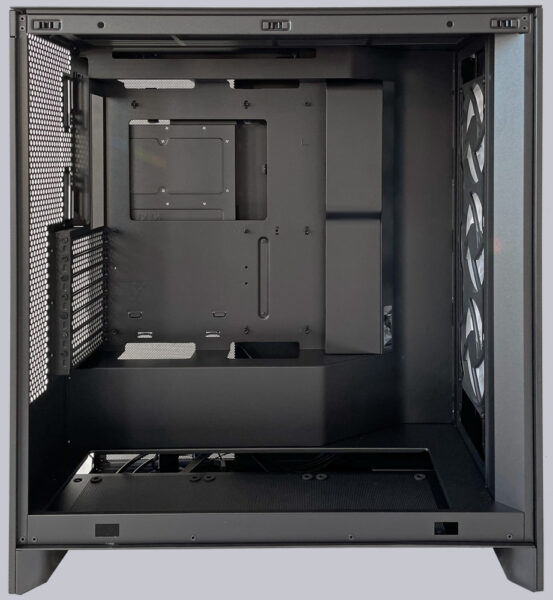
Layout, design and features interior
Inside, the housing can accommodate motherboards in the form factors E-ATX (up to 277mm wide), ATX, Micro-ATX and Mini-ITX. The spacers must be adjusted accordingly. One spacer has a pin in the middle, which allows the mainboard to be locked in place for the first time during installation. This makes installation easier.

Behind the mesh are 3x 120mm fans, which are all mounted together in a housing with just one connection. Separation is therefore not possible. Unfortunately, NZXT has also dispensed with removable dust filters in the front. This would have made cleaning easier. However, most of the dust should remain on the front. The so-called NZXT F360 RGB Core Fan, which we recently tested, can be controlled using a 3-pin fan connector.

RGB lighting is also available, which can be controlled via the 3-pin standard ARGB header. Multicolored effects, such as the rainbow effect, are also possible thanks to the addressable RGB control. A maximum of 3x 140mm fans would be possible in the front, which would further enhance the design. The existing 120mm fans in the fan frame do not completely fill the front, leaving a gap around the outside.

Alternatively, you could install 3x NZXT F140 RGB Core fans. If, on the other hand, you don’t want to install RGB fans, you could fall back on the brand new Cooler Master Mobius 140 Black Edition, for example, which has just been secretly released by Cooler Master as a 140mm and 120mm version. We already had the Cooler Master Mobius 120 and 120P ARGB in our test, but of course they look particularly classy in full black.

At the rear, the H7 Flow RGB provides plenty of storage space for the cables. With a width of 34.5mm, even the most complicated cable management is possible. There is also the option of installing up to 4 2.5 inch drives or up to 2 3.5 inch drives. Velcro strips for optimum cable routing are also already attached.

NZXT H7 Flow RGB Practical testing …

